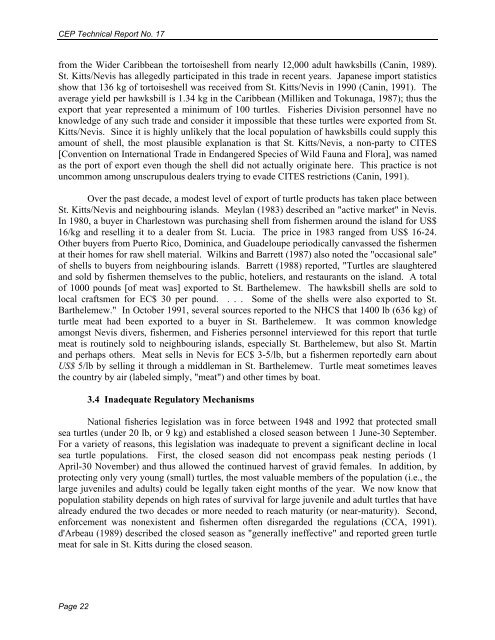Sea Turtle Recovery Action Plan for St. Kitts and Nevis - WIDECAST
Sea Turtle Recovery Action Plan for St. Kitts and Nevis - WIDECAST
Sea Turtle Recovery Action Plan for St. Kitts and Nevis - WIDECAST
You also want an ePaper? Increase the reach of your titles
YUMPU automatically turns print PDFs into web optimized ePapers that Google loves.
CEP Technical Report No. 17<br />
from the Wider Caribbean the tortoiseshell from nearly 12,000 adult hawksbills (Canin, 1989).<br />
<strong>St</strong>. <strong>Kitts</strong>/<strong>Nevis</strong> has allegedly participated in this trade in recent years. Japanese import statistics<br />
show that 136 kg of tortoiseshell was received from <strong>St</strong>. <strong>Kitts</strong>/<strong>Nevis</strong> in 1990 (Canin, 1991). The<br />
average yield per hawksbill is 1.34 kg in the Caribbean (Milliken <strong>and</strong> Tokunaga, 1987); thus the<br />
export that year represented a minimum of 100 turtles. Fisheries Division personnel have no<br />
knowledge of any such trade <strong>and</strong> consider it impossible that these turtles were exported from <strong>St</strong>.<br />
<strong>Kitts</strong>/<strong>Nevis</strong>. Since it is highly unlikely that the local population of hawksbills could supply this<br />
amount of shell, the most plausible explanation is that <strong>St</strong>. <strong>Kitts</strong>/<strong>Nevis</strong>, a non-party to CITES<br />
[Convention on International Trade in Endangered Species of Wild Fauna <strong>and</strong> Flora], was named<br />
as the port of export even though the shell did not actually originate here. This practice is not<br />
uncommon among unscrupulous dealers trying to evade CITES restrictions (Canin, 1991).<br />
Over the past decade, a modest level of export of turtle products has taken place between<br />
<strong>St</strong>. <strong>Kitts</strong>/<strong>Nevis</strong> <strong>and</strong> neighbouring isl<strong>and</strong>s. Meylan (1983) described an "active market" in <strong>Nevis</strong>.<br />
In 1980, a buyer in Charlestown was purchasing shell from fishermen around the isl<strong>and</strong> <strong>for</strong> US$<br />
16/kg <strong>and</strong> reselling it to a dealer from <strong>St</strong>. Lucia. The price in 1983 ranged from US$ 16-24.<br />
Other buyers from Puerto Rico, Dominica, <strong>and</strong> Guadeloupe periodically canvassed the fishermen<br />
at their homes <strong>for</strong> raw shell material. Wilkins <strong>and</strong> Barrett (1987) also noted the "occasional sale"<br />
of shells to buyers from neighbouring isl<strong>and</strong>s. Barrett (1988) reported, "<strong>Turtle</strong>s are slaughtered<br />
<strong>and</strong> sold by fishermen themselves to the public, hoteliers, <strong>and</strong> restaurants on the isl<strong>and</strong>. A total<br />
of 1000 pounds [of meat was] exported to <strong>St</strong>. Barthelemew. The hawksbill shells are sold to<br />
local craftsmen <strong>for</strong> EC$ 30 per pound. . . . Some of the shells were also exported to <strong>St</strong>.<br />
Barthelemew." In October 1991, several sources reported to the NHCS that 1400 lb (636 kg) of<br />
turtle meat had been exported to a buyer in <strong>St</strong>. Barthelemew. It was common knowledge<br />
amongst <strong>Nevis</strong> divers, fishermen, <strong>and</strong> Fisheries personnel interviewed <strong>for</strong> this report that turtle<br />
meat is routinely sold to neighbouring isl<strong>and</strong>s, especially <strong>St</strong>. Barthelemew, but also <strong>St</strong>. Martin<br />
<strong>and</strong> perhaps others. Meat sells in <strong>Nevis</strong> <strong>for</strong> EC$ 3-5/lb, but a fishermen reportedly earn about<br />
US$ 5/lb by selling it through a middleman in <strong>St</strong>. Barthelemew. <strong>Turtle</strong> meat sometimes leaves<br />
the country by air (labeled simply, "meat") <strong>and</strong> other times by boat.<br />
3.4 Inadequate Regulatory Mechanisms<br />
National fisheries legislation was in <strong>for</strong>ce between 1948 <strong>and</strong> 1992 that protected small<br />
sea turtles (under 20 lb, or 9 kg) <strong>and</strong> established a closed season between 1 June-30 September.<br />
For a variety of reasons, this legislation was inadequate to prevent a significant decline in local<br />
sea turtle populations. First, the closed season did not encompass peak nesting periods (1<br />
April-30 November) <strong>and</strong> thus allowed the continued harvest of gravid females. In addition, by<br />
protecting only very young (small) turtles, the most valuable members of the population (i.e., the<br />
large juveniles <strong>and</strong> adults) could be legally taken eight months of the year. We now know that<br />
population stability depends on high rates of survival <strong>for</strong> large juvenile <strong>and</strong> adult turtles that have<br />
already endured the two decades or more needed to reach maturity (or near-maturity). Second,<br />
en<strong>for</strong>cement was nonexistent <strong>and</strong> fishermen often disregarded the regulations (CCA, 1991).<br />
d'Arbeau (1989) described the closed season as "generally ineffective" <strong>and</strong> reported green turtle<br />
meat <strong>for</strong> sale in <strong>St</strong>. <strong>Kitts</strong> during the closed season.<br />
Page 22
















